Summary
Click on the pictures to enlarge them and click on the tabs for more information and recommendations. As mentioned in the Special Considerations section, most places in Berlin only accept cash or debit.
Berlin is a cosmopolitan metropolis with a rich history. It is home to a collection of magnificent museums, the Berlin Wall, and other world-class and historically-important attractions.
Berlin—Germany’s capital and largest city—exerts tremendous influence on the world stage in areas such as commerce, culture, politics, and science, among others. Berlin is also quite beautiful and well-designed. The Spree river, architecture, and nature all blend together to emphasize this city’s beauty.
For a number of reasons (to be seen in the attractions and adventurous activities section), Berlin is one of my favorite cities in the world.
Follow this adventure guide to maximize your time here.
Recommended Duration of Visit
4 days (ideal), 3 days (doable), 2 days (difficult)
Click for some interesting facts about Berlin
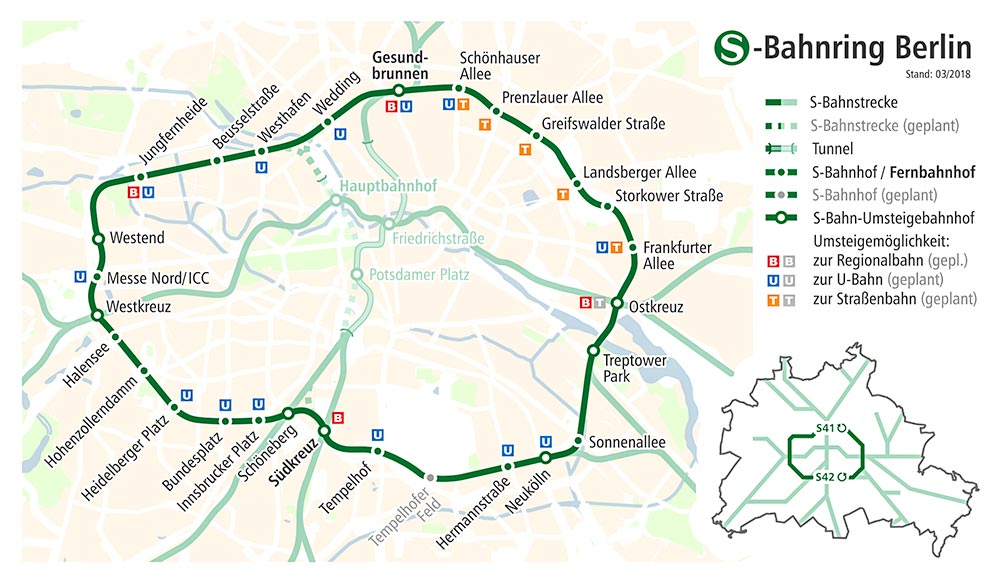
Flights / Getting There: Since Berlin is a major city, you can simply fly into Berlin Tegel or Berlin Schönefeld.
Both airports offer taxi services to Berlin’s city center. This method of transportation is ideal for large groups of at least 4. Alternatively, there are numerous railways heading directly to the city center.
Climate: Berlin has an oceanic climate with mild summers and cool (but not too cold) winters. Basically, it’s kinda meh—not too hot, not too cold.
Communication: German is the official language, but English is widely spoken as well.
Navigation: Google Maps will help tremendously because it will tell you which railway to take.
Hauptbahnhof and Ostbahnhoff are the main railway stations. Refer to the Special Considerations section below for more information on using the railway stations.
You must validate your railway ticket by inserting it into a small machine. They also check tickets very often, and the fine is around 60 euros for a ticket. You can download the DB Navigator app for an easily-managed virtual ticket.
Rentable scooters, scattered throughout the city, are some of the best and most fun methods of transportation throughout Berlin.
Lodging: Lodging in Berlin is moderately expensive. As usual, prioritize hostels or Airbnb’s to reduce costs. If possible, stay near a railway station or anywhere near Museum Island (central Berlin). I stayed at a hostel named St Christopher’s Inn Berlin Alexanderplatz.
Activities Planning: If you wish to visit multiple museums on Museum Island, then I highly recommend the Museum Pass.
Fortunately, the main Berlin website allows you to purchase tickets for most attractions.
Special Considerations
General: Student ID’s will greatly help reduce costs at numerous attractions, especially the museums.
Peak Seasons: Summer (June, July, and August) and late September (mostly due to Oktoberfest) are the peak seasons.
Currency: The European Union’s Euro (EUR). Currency Converter.
Attractions are paired up based on similarity and/or proximity. If you wish to visit multiple museums on Museum Island, then I highly recommend the Museum Pass. The main Berlin website allows you to purchase tickets for most attractions.
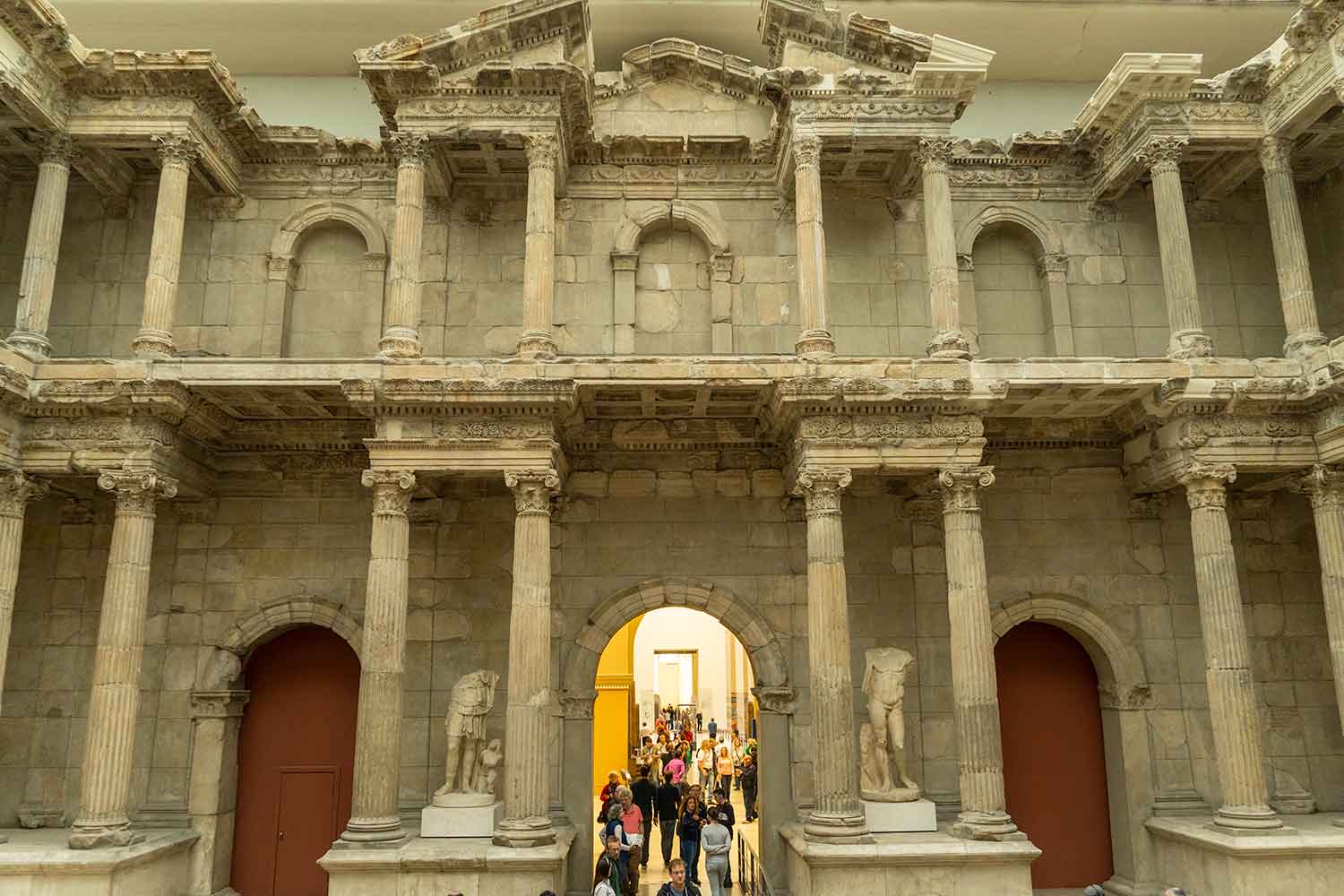 Pergamonmuseum (Pergamon Museum): The Pergamon Museum, located on Museum Island, is a UNESCO World Heritage site and one of Germany’s most visited museums.
Pergamonmuseum (Pergamon Museum): The Pergamon Museum, located on Museum Island, is a UNESCO World Heritage site and one of Germany’s most visited museums.
The Pergamon’s main exhibits are its monumental reconstructions such as the Ishtar Gate of Babylon, the Pergamon Altar (from the ancient Greek city of Pergamon), the Market Gate of Miletus, and Mesopotamia, among others. These reconstructions are several stories high and occasionally span the length of an entire room.
There are three main subdivisions: The Antiquity Collection, the Middle East collection, and the Islamic Art collection. The massive reconstructions provide a truly immersive experience—showing visitors what it would be like walking through the past.
Cost: You can find more information and buy tickets on the official Pergamon Museum website. You can also buy tickets in person and select special packaged deals. Recommended Duration of Visit: 2 – 4 hours.
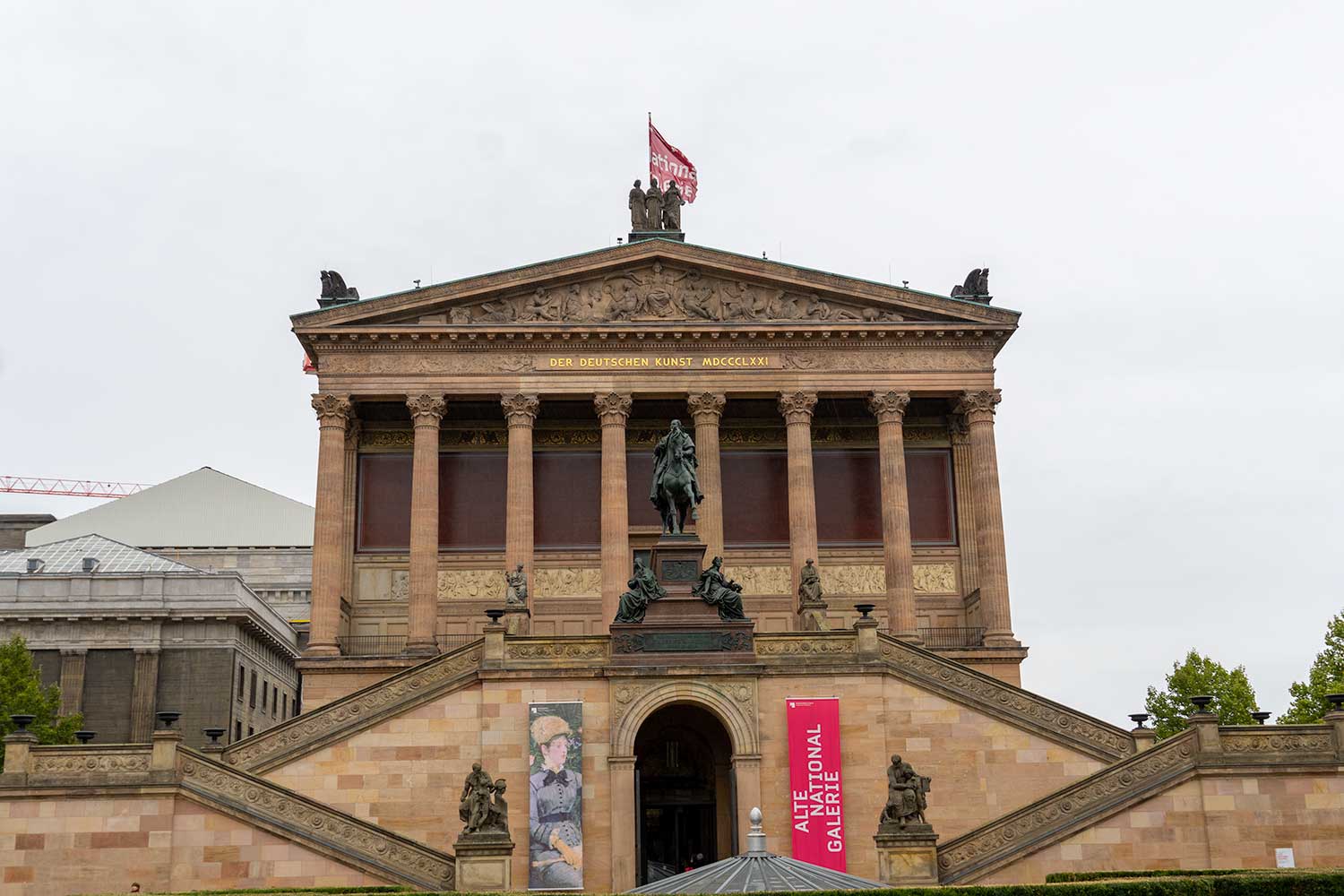 Alte Nationalgalerie (Old National Gallery): The Old National Gallery, located on Museum Island and connected to the Pergamon Museum, is a UNESCO World Heritage Site and a “sanctuary for art and science.” It features Neoclassical, Romantic, and Modernist artwork, among others.
Alte Nationalgalerie (Old National Gallery): The Old National Gallery, located on Museum Island and connected to the Pergamon Museum, is a UNESCO World Heritage Site and a “sanctuary for art and science.” It features Neoclassical, Romantic, and Modernist artwork, among others.
Cost: You can find more information and buy tickets on the official Old National Gallery website. Recommended Duration of Visit: 1 – 2 hours.
| Unless you are fluent in German, grab a free audio box for translations, because many descriptions are only in German. Backpacks are not allowed, so you will have to check them in. |
| There are kiosks located nearby (outside and inside this museum). These kiosks offer the Museum Pass that gives you access to multiple museums on Museum Island. |
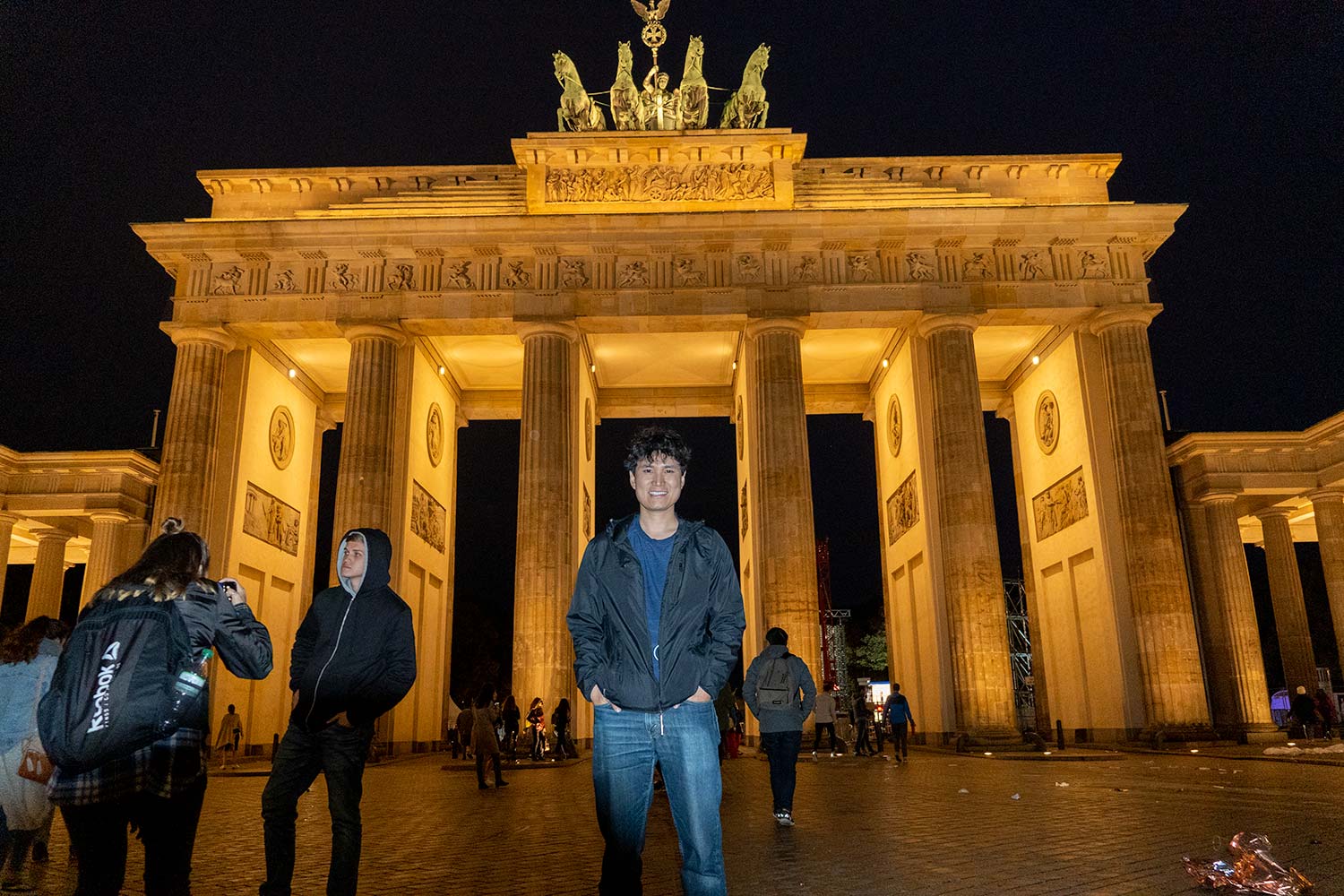 Brandenburg Gate: Brandenburg Gate was built under the orders of Frederick William II as an entry point into Berlin. As one of the best-known landmarks in Germany, it features elegant 18th century neoclassical architecture. At the gate’s summit is Quadriga—a chariot drawn by four horses. Victoria (the goddess of Victory) commands the chariot.
Brandenburg Gate: Brandenburg Gate was built under the orders of Frederick William II as an entry point into Berlin. As one of the best-known landmarks in Germany, it features elegant 18th century neoclassical architecture. At the gate’s summit is Quadriga—a chariot drawn by four horses. Victoria (the goddess of Victory) commands the chariot.
Throughout history, Brandenburg Gate has been a symbol of division, unity, peace, and the turbulent history of Europe and Germany. It is a major historical site (Napoleon even stole the statue of Quadriga once) and a majestic attraction.
Cost: Free to visit. Recommended Duration of Visit: 30 – 60 minutes.
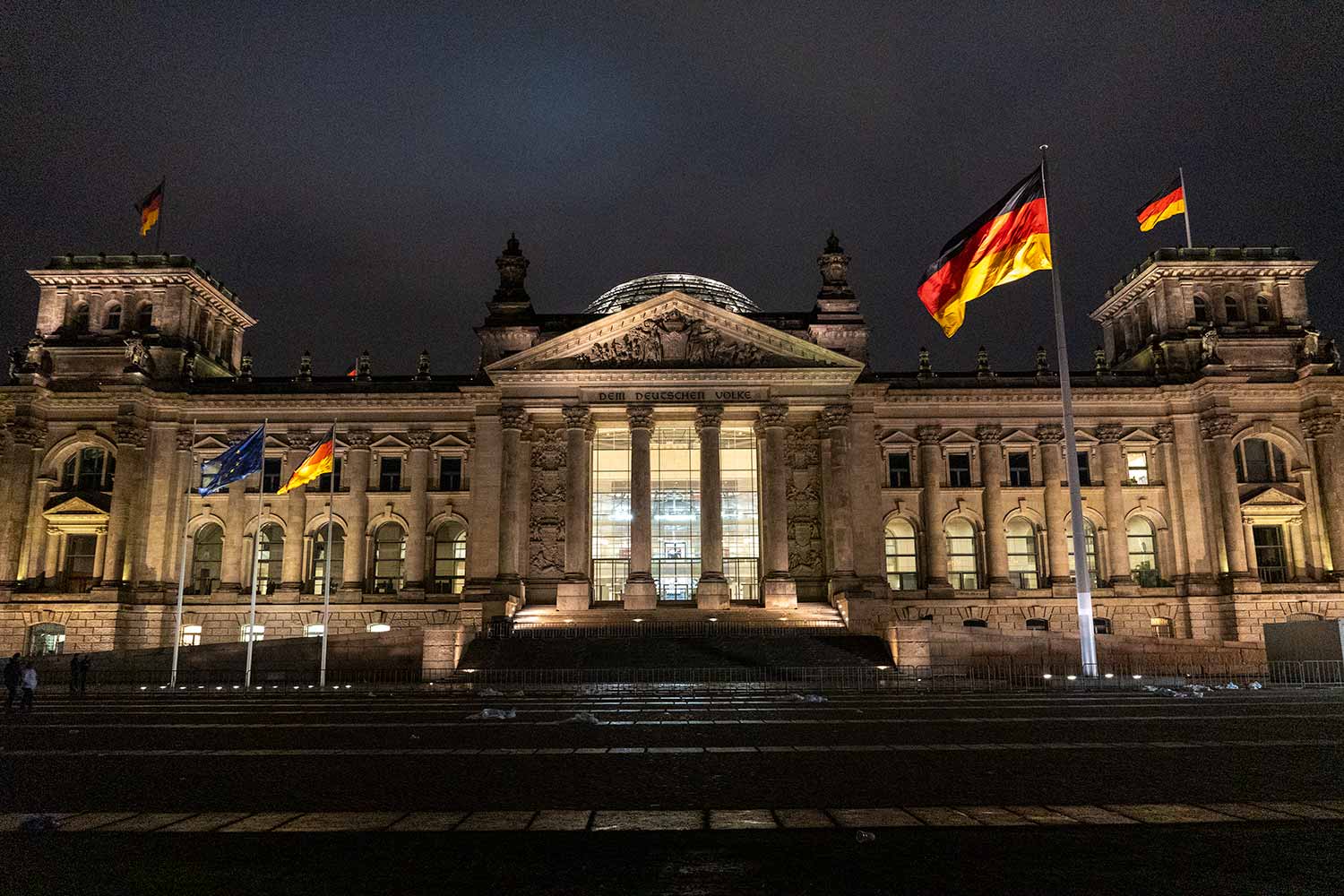 Reichstag Building: This building is the meeting place of the Bundestag—the German federal parliament. The iconic dome was designed to let in copious amounts of sunlight. And even though the dome also has a 360-degree view of Berlin, visitors can simply enjoy a nice view on the roof (outside of the dome). The interior features exhibitions and some history.
Reichstag Building: This building is the meeting place of the Bundestag—the German federal parliament. The iconic dome was designed to let in copious amounts of sunlight. And even though the dome also has a 360-degree view of Berlin, visitors can simply enjoy a nice view on the roof (outside of the dome). The interior features exhibitions and some history.
Cost: Free to visit, but a reservation is necessary. You also need to bring an identity document. You can find more information and buy tickets on the official Reichstag Building website. Recommended Duration of Visit: 1 – 2 hours.
| Brandenburg Gate is in a very festive and fun area, so you can be here for hours. In my opinion, Brandenburg Gate looks best at night (due to the incredible lighting). If you ask nicely, some people might move aside so you can take your photo. |
| Reservations should me made at least one day (and preferably two) days in advance. You can also make reservations in person at the booking office. As you face the building, the reservation area is to the right side (in a small building). |
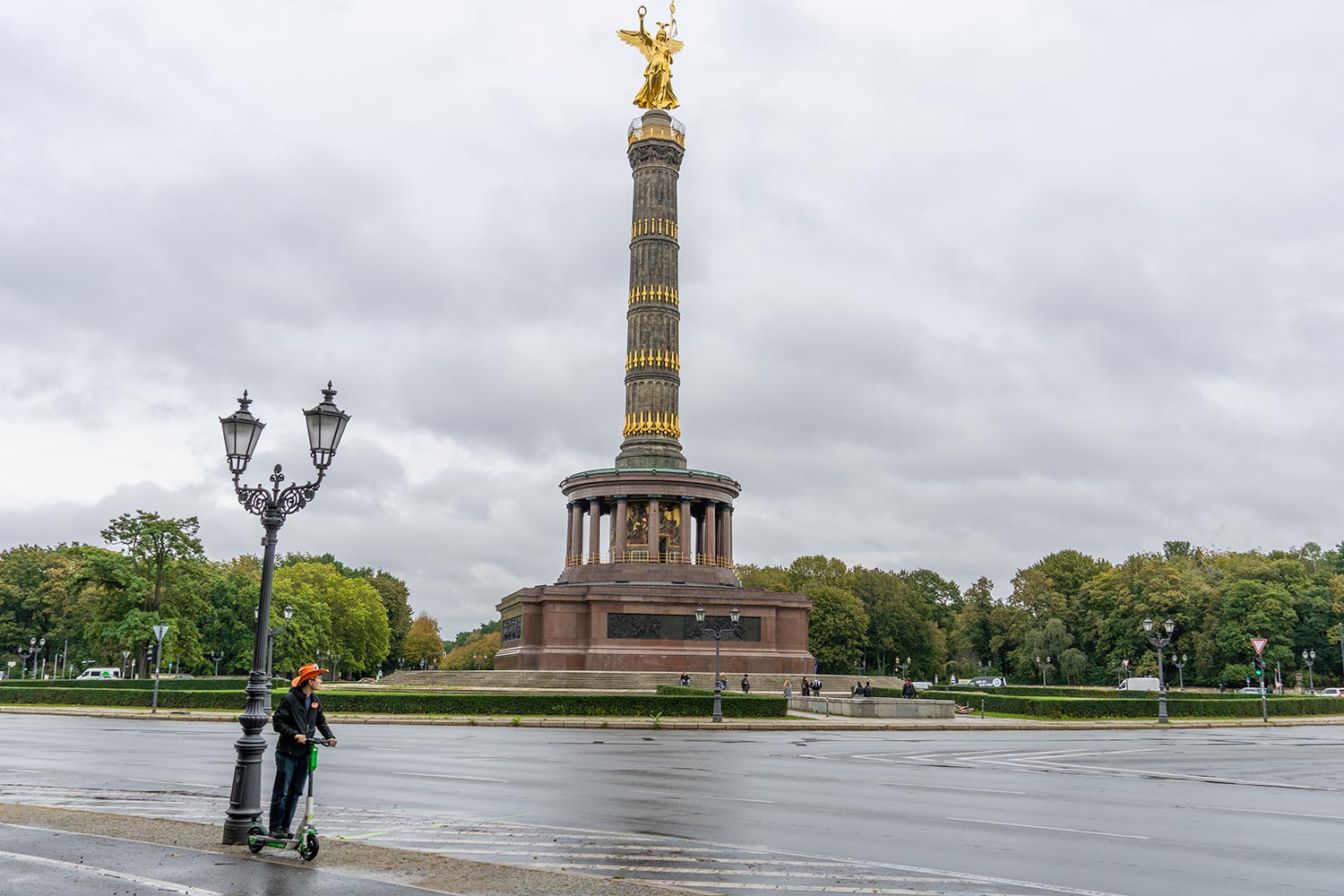 Siegessäule (Victory Column): The Victory Column, located in the district of Tiergarten, commemorates the Prussian victory in the Danish-Prussian War. The statue of Victoria (the goddess of victory) was added after victories in the Austro-Prussian War and the Franco-Prussian War. The column (including the statue) is 219 feet (67 meters) tall. Some Berliners refer to the statue as Goldelse (Golden Lizzie).
Siegessäule (Victory Column): The Victory Column, located in the district of Tiergarten, commemorates the Prussian victory in the Danish-Prussian War. The statue of Victoria (the goddess of victory) was added after victories in the Austro-Prussian War and the Franco-Prussian War. The column (including the statue) is 219 feet (67 meters) tall. Some Berliners refer to the statue as Goldelse (Golden Lizzie).
Tiergarten is the name of the district and the huge park it contains. This park is worth visiting and contains some very notable attractions such as the Berlin Zoo and the Soviet War Memorial.
Cost: Free to visit, but the entry to the observation deck costs 3 euros (2.5 euros for students). Recommended Duration of Visit: 30 – 60 minutes.
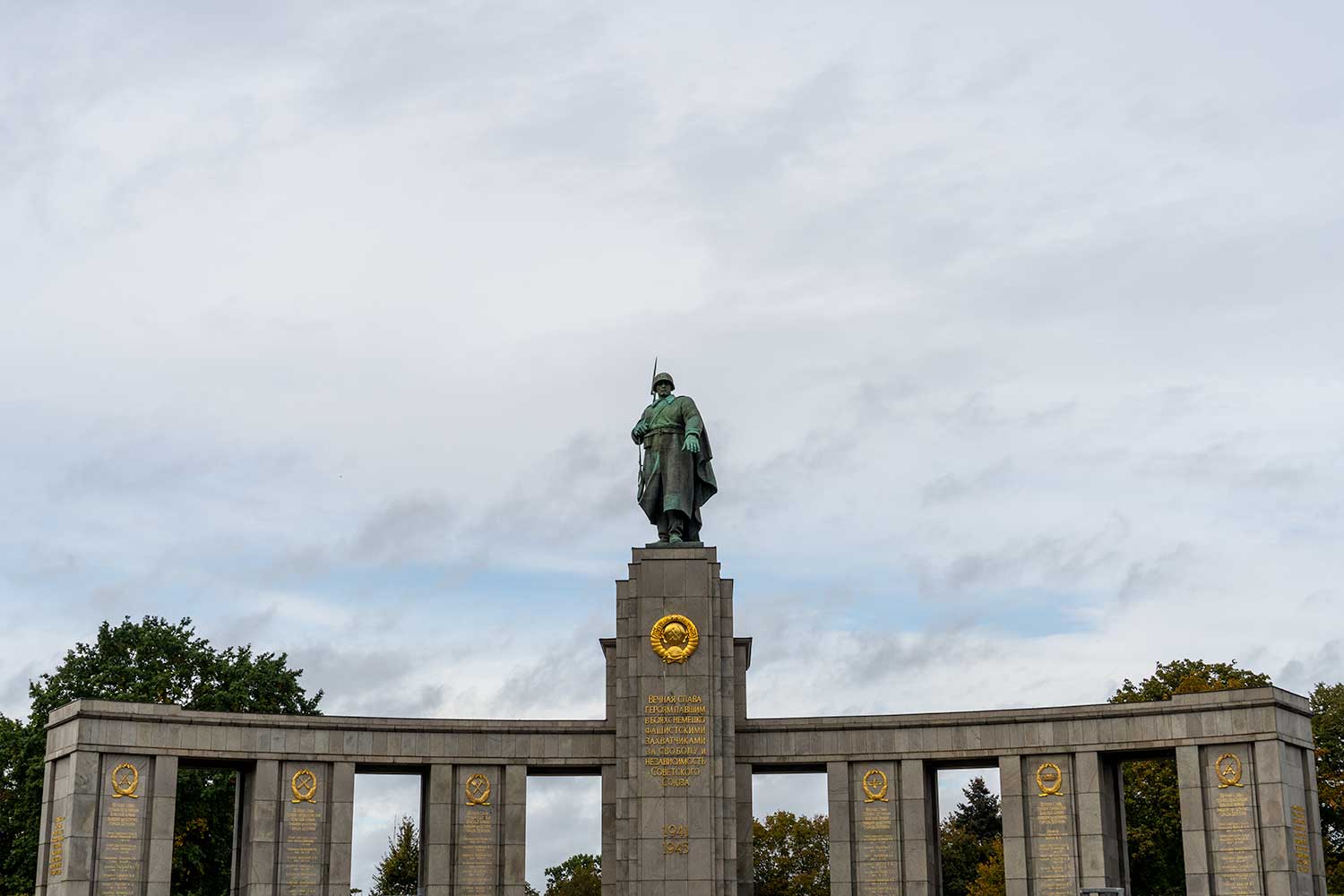 Soviet War Memorial Tiergarten: This memorial, located in Tiergarten Park, was erected by the Soviet Union to commemorate the fallen soldiers in the Battle of Berlin. It was erected in 1945, within a few months of capturing Berlin.
Soviet War Memorial Tiergarten: This memorial, located in Tiergarten Park, was erected by the Soviet Union to commemorate the fallen soldiers in the Battle of Berlin. It was erected in 1945, within a few months of capturing Berlin.
The memorial is surrounded by artillery and tanks. The inscription translates as, “Eternal glory to heroes who fell in battle with the German fascist invaders for the freedom and independence of the Soviet Union.” It is also the burial site of about 2,000 Soviet soldiers.
Cost: Free to visit. Recommended Duration of Visit: 15 – 30 minutes.
| You can pay to access the Victory Column’s observation deck. Do note that the column is at the center of a giant roundabout. |
| There is a small outdoor museum behind the memorial that provides some history. |
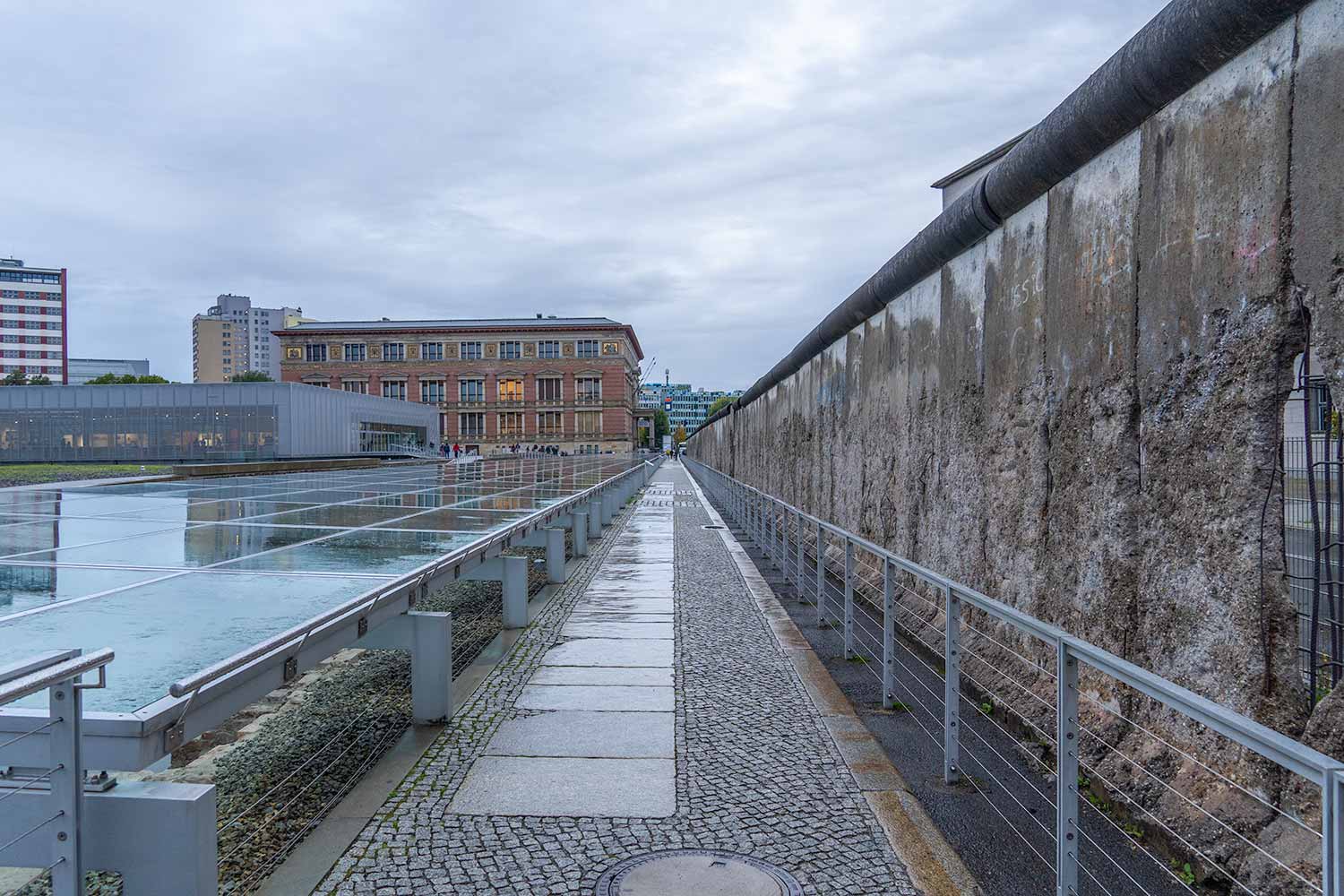 Berlin Wall: From 1961 to 1989, this concrete wall represented the physical and ideological division in Berlin. At the end of World War 2, Berlin was divided into four zones. The eastern half was the Soviet zone. The western half was divided into American, British, and French zones.
Berlin Wall: From 1961 to 1989, this concrete wall represented the physical and ideological division in Berlin. At the end of World War 2, Berlin was divided into four zones. The eastern half was the Soviet zone. The western half was divided into American, British, and French zones.
The wall was built to prevent the mass exodus of people from the East (because the West was more prosperous). As a major historic landmark, the wall’s construction symbolized division, and its destruction symbolized unity.
This section of the wall is near the Topography of Terror—a center documenting Nazi atrocities. This location also provides a detailed history of World War 2. Most notably, the information boards showcase the bravery and sacrifice of Poland.
Cost: Free to visit. Recommended Duration of Visit: 1 – 2 hours.
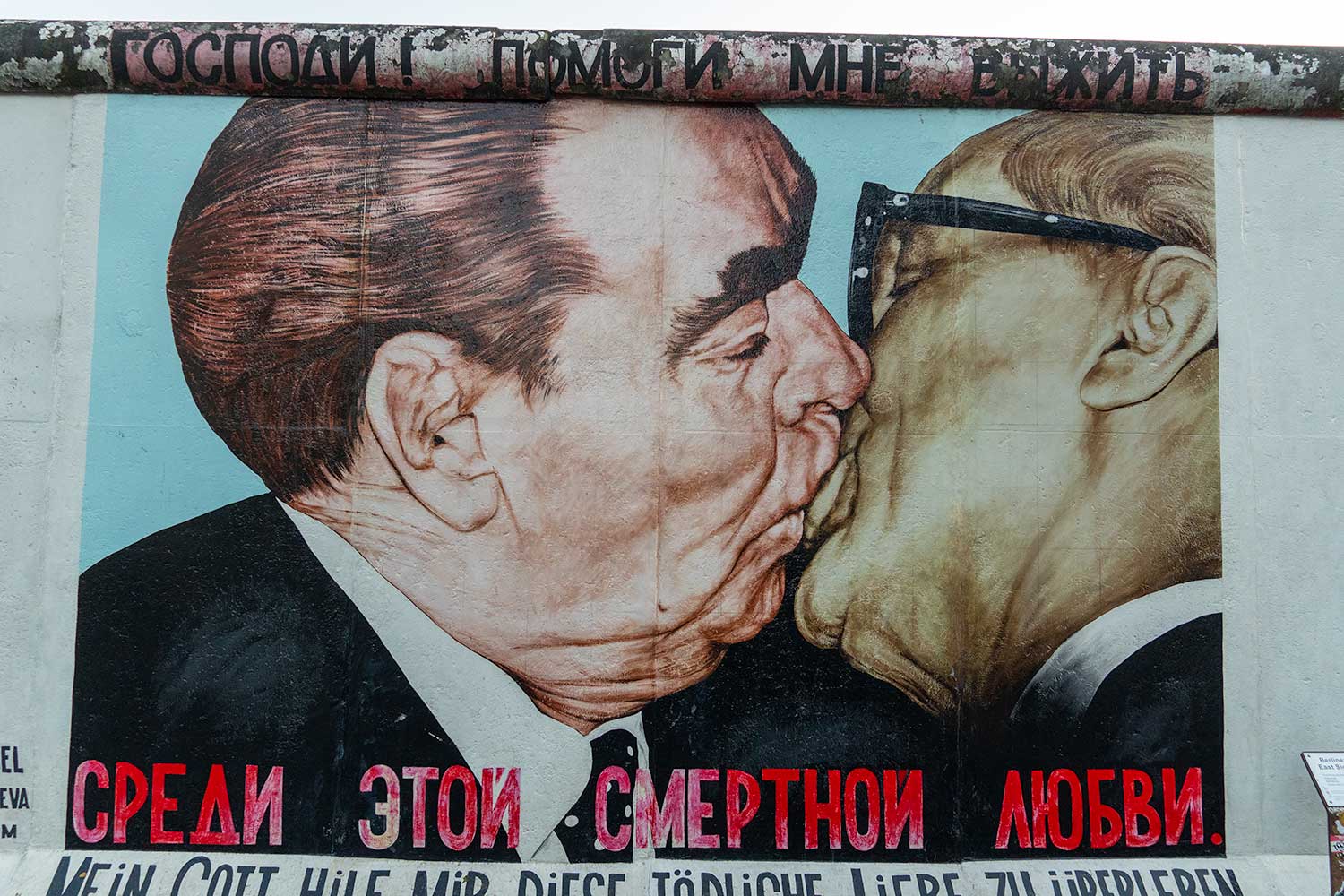 East Side Gallery: This open-air gallery—featuring murals painted directly on a section of the Berlin Wall—is one of the largest open-air galleries in the world. At 4318 feet (1316 meters) long, the East Side Gallery offers a lovely walk along the river, mesmerizing street art that encompasses the history and culture of Berlin, a rich history, and a festive atmosphere. This memorial to the fall of the Berlin Wall consists of over 100 artworks.
East Side Gallery: This open-air gallery—featuring murals painted directly on a section of the Berlin Wall—is one of the largest open-air galleries in the world. At 4318 feet (1316 meters) long, the East Side Gallery offers a lovely walk along the river, mesmerizing street art that encompasses the history and culture of Berlin, a rich history, and a festive atmosphere. This memorial to the fall of the Berlin Wall consists of over 100 artworks.
The world-renowned masterpiece (the one with the two men kissing), created by Russian painter Dmitri Vrubel, depicts the Soviet leader Leonid Brezhnev and the East Germany President Erich Honecker passionately kissing.
Yes, the two men indeed kissed (and they were REALLY into it). “The Kiss” was a special form of greeting to demonstrate a special connection between socialist countries. The text translates to: “My God, help me to survive this deadly love.”
Cost: Free to visit. Recommended Duration of Visit: 1 – 2 hours.
| This section of the Berlin Wall, located at Niederkirchnerstraße 1, 10117 Berlin, is west of Checkpoint Charlie—a historical crossing point between East and West Berlin during the Cold War. |
| Since the East Side Gallery is a very long section of the Berlin Wall, you might have to walk a while before you start seeing reconizable art (like the one shown above). |
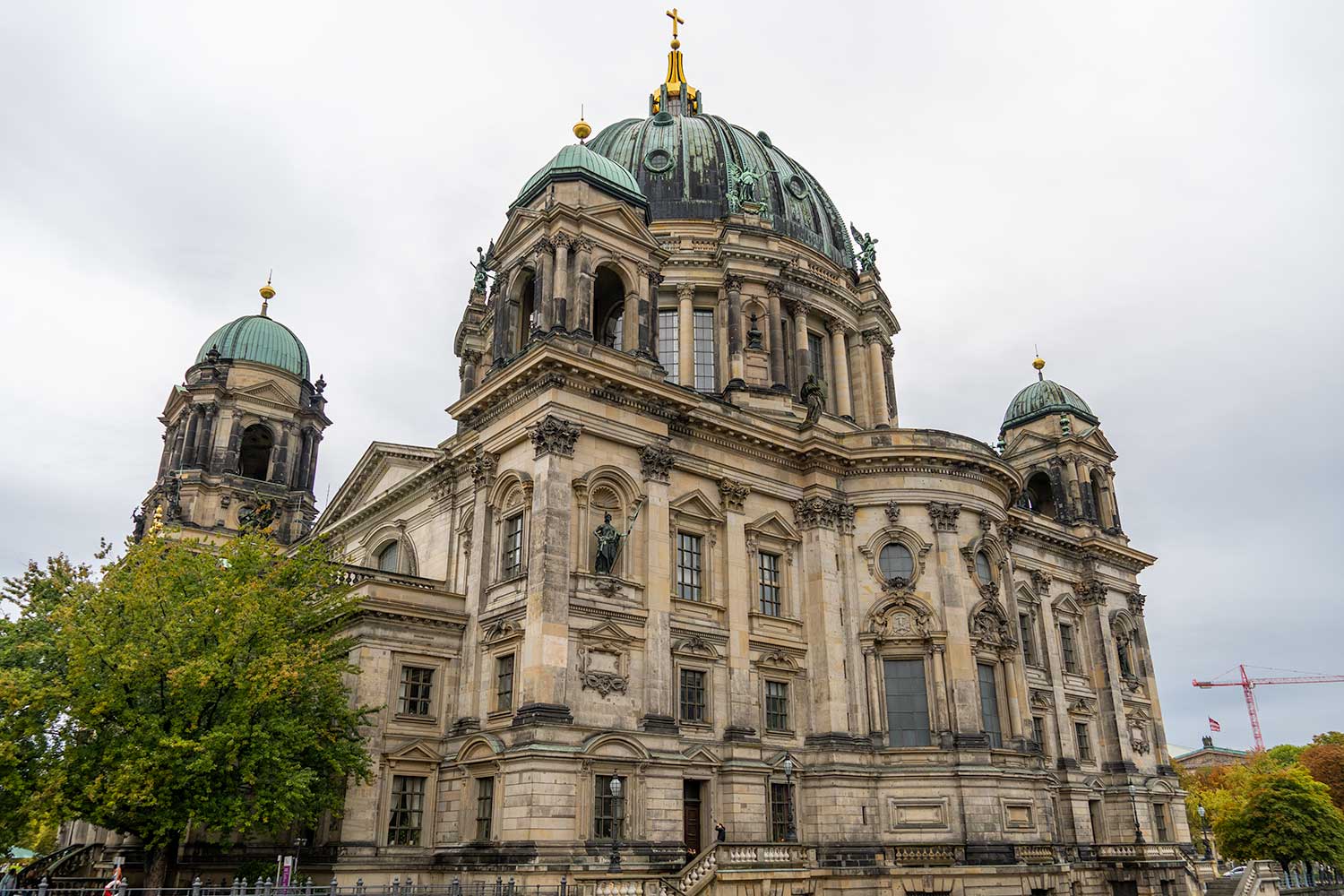 Berlin Cathedral: The Berlin Cathedral, located on Museum Island, is one of the most recognizable sites in Berlin. The interior of this massive Evangelical cathedral is striking, leaving one in awe of its unique architectural design and sheer vastness.
Berlin Cathedral: The Berlin Cathedral, located on Museum Island, is one of the most recognizable sites in Berlin. The interior of this massive Evangelical cathedral is striking, leaving one in awe of its unique architectural design and sheer vastness.
The cathedral also features a rich history, numerous elaborate exhibits, ornate displays, and a crypt, among others. As a bonus, there is an observation deck that offers a breathtaking panoramic view of Berlin’s skyline. There is also a cafe (toward the exit). If you refer to my Berlin Cathedral Guide, then you will see how truly amazing this place is.
Cost: You can find more information and buy tickets on the official Berlin Cathedral website. Recommended Duration of Visit: 1 – 2 hours.
| It takes about 257 steps to reach the observation deck. For the best view, try to visit around noon or sunset. |
| St. Mary’s Church is in a centralized location, giving you maximum flexibility to head in any direction as you plan your itinerary. |
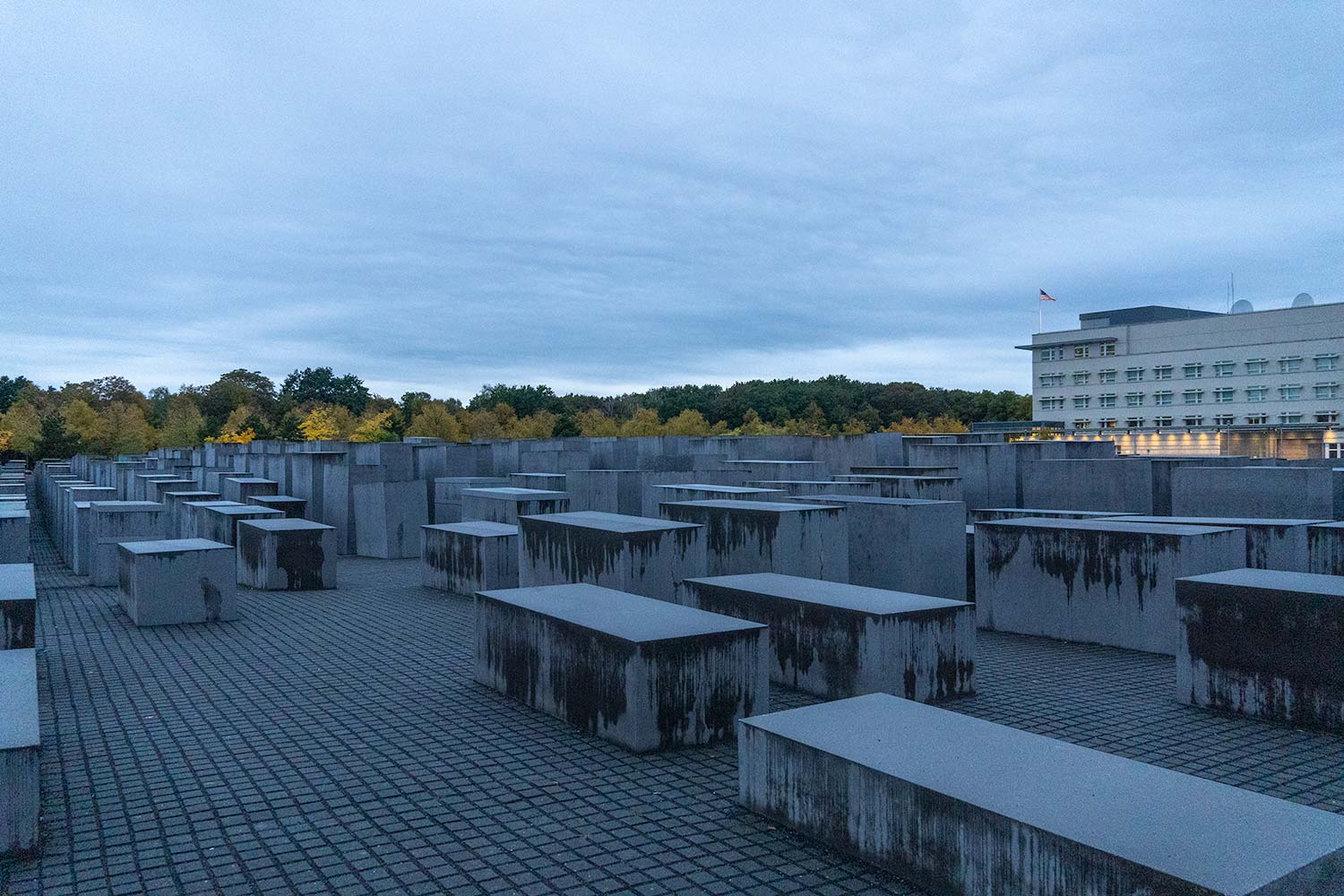 Holocaust Memorial (Memorial to the Murdered Jews of Europe): This memorial, dedicated to the Jewish victims of the Holocaust, consists of 2711 gray concrete stelae (slabs) arranged on a sloping field that spans 200,000 square feet (18,600 square meters).
Holocaust Memorial (Memorial to the Murdered Jews of Europe): This memorial, dedicated to the Jewish victims of the Holocaust, consists of 2711 gray concrete stelae (slabs) arranged on a sloping field that spans 200,000 square feet (18,600 square meters).
The Place of Information (underground exhibit) holds the names of approximately 3 million Jewish Holocaust victims. In the underground exhibit, there is a timeline of events alongside displays of heartbreaking letters of victims. One of the memorial’s most profound messages is: “It happened, therefore it can happen again: this is the core of what we have to say.”
Cost: The memorial is free to visit, but the underground exhibit costs a small fee (3 euros when I went). Recommended Duration of Visit: 1 – 2 hours.
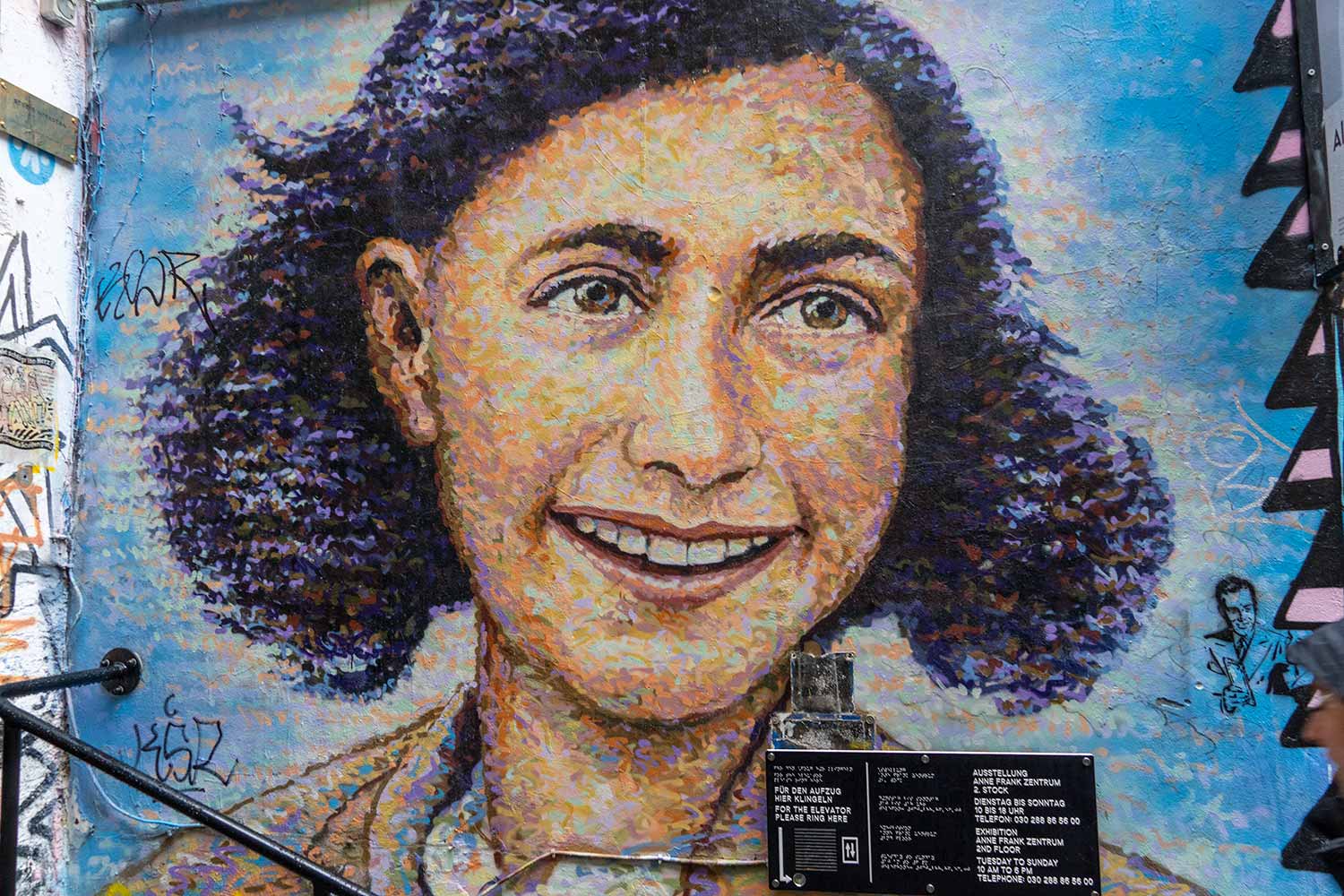 Anne Frank Zetrium (Anne Frank Center): Anne Frank’s diary (i.e. The Diary of a Young Girl) is world-renowned and widely-praised for its literary merits, moving story, and profound wisdom. As a symbol of the Holocaust, she was one voice that spoke for the 6 million victims.
Anne Frank Zetrium (Anne Frank Center): Anne Frank’s diary (i.e. The Diary of a Young Girl) is world-renowned and widely-praised for its literary merits, moving story, and profound wisdom. As a symbol of the Holocaust, she was one voice that spoke for the 6 million victims.
This wonderful museum contains very detailed accounts of Anne Frank’s life and the world she lived in—complete with descriptions, interviews, letters, and photographs. The Zentrum’s goal is to work against any kind of discrimination against people.
Cost: You can find more information and buy tickets on the official Anne Frank Zetrium website. Recommended Duration of Visit: 1 – 2 hours.
| The exhibit entrance is near the outer edge. The exhibit is closed on Mondays. Photography of the entrance is prohibited. The Jewish Memorial is north of the Berlin Wall (the one near the Topography of Terror), but visiting both in the same day can be saddening because they cover some horrific events. I recommend separating these attractions into two separate dates if possible. |
| The audio guides are integral to a complete experience. The Museum caters to the deaf and blind as well. This museum contains an abundant amount of text, videos, and photographs, so it should not be rushed. The entrance is slightly tricky to find, so make sure to look for the stairways next to the artwork of Anne Frank (shown in the photo). |
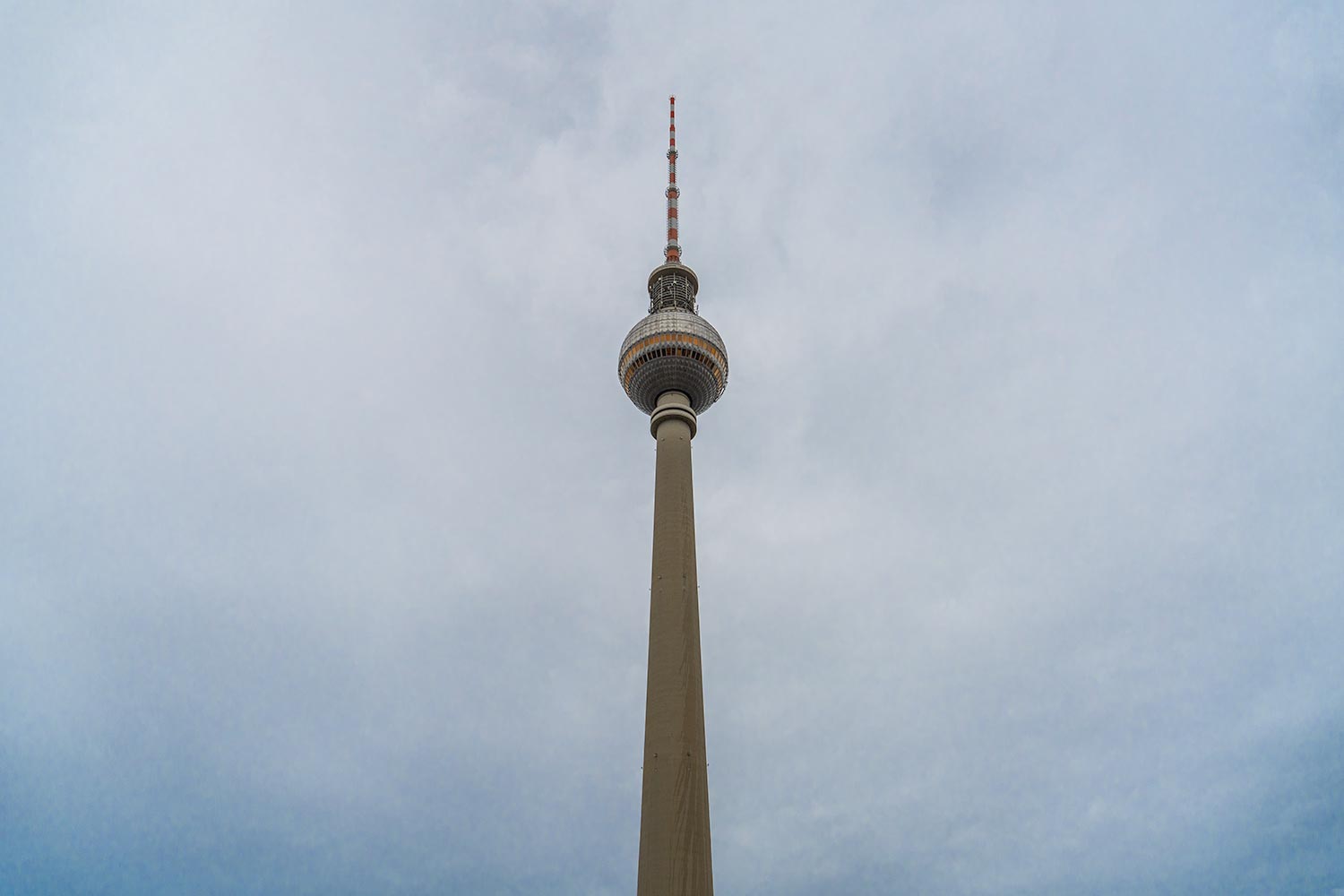 Fernsehturm (Television Tower): As one of the most recognized landmarks in Berlin, the Fernsehturm stands at 1207 feet (368 meters), making it is easily one of the tallest freestanding structures in Europe.
Fernsehturm (Television Tower): As one of the most recognized landmarks in Berlin, the Fernsehturm stands at 1207 feet (368 meters), making it is easily one of the tallest freestanding structures in Europe.
The observation deck (the sphere-looking thing) is at 666 feet ( 203 meters), providing a panoramic view of the city. The lift takes approximately 40 seconds to reach the observation deck. There is a cool bar (Bar 203) on the observation deck floor.
Cost: You can find more information and buy tickets on the official Fernsehturm website. Recommended Duration of Visit: 1 – 2 hours.
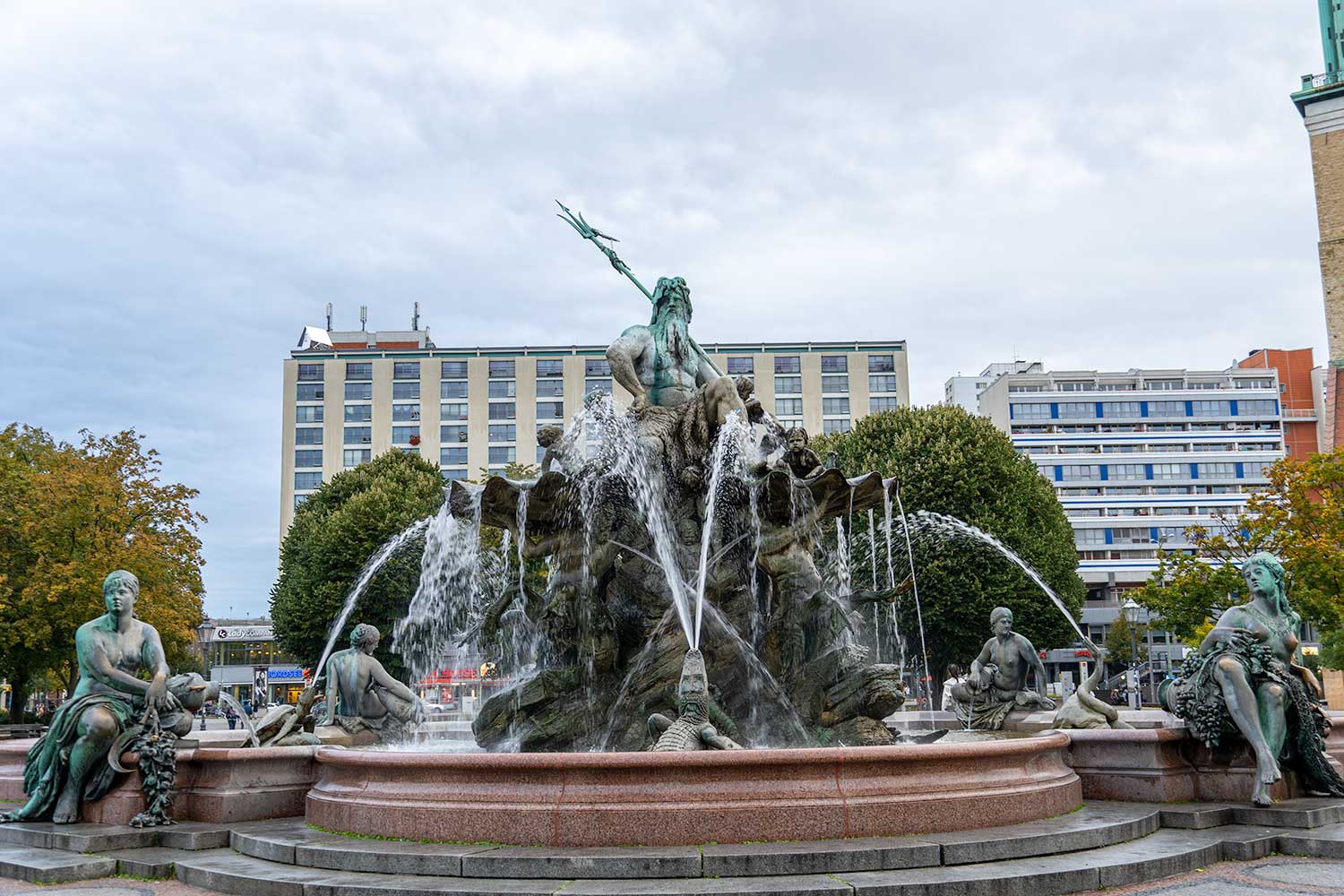 Neptunbrunnen (Neptune Fountain): The Neptune Fountain, based on the Roman god Neptune, was built in 1891. Four women surround Neptune—each of them representing one of the 4 main rivers in Prussia (Elbe, Rhine, Vistula, and Oder).
Neptunbrunnen (Neptune Fountain): The Neptune Fountain, based on the Roman god Neptune, was built in 1891. Four women surround Neptune—each of them representing one of the 4 main rivers in Prussia (Elbe, Rhine, Vistula, and Oder).
The fountain’s diameter is 59 feet (18 meters) and its height is 33 feet (10 meters).
Cost: Free to visit. Recommended Duration of Visit: 10 – 15 minutes.
| Note that protective glass surrounds the observation deck, so taking photos is slightly trickier. |
| The fountain is in a centralized location (near St. Mary’s Church), making it a flexible location for itinerary planning. |
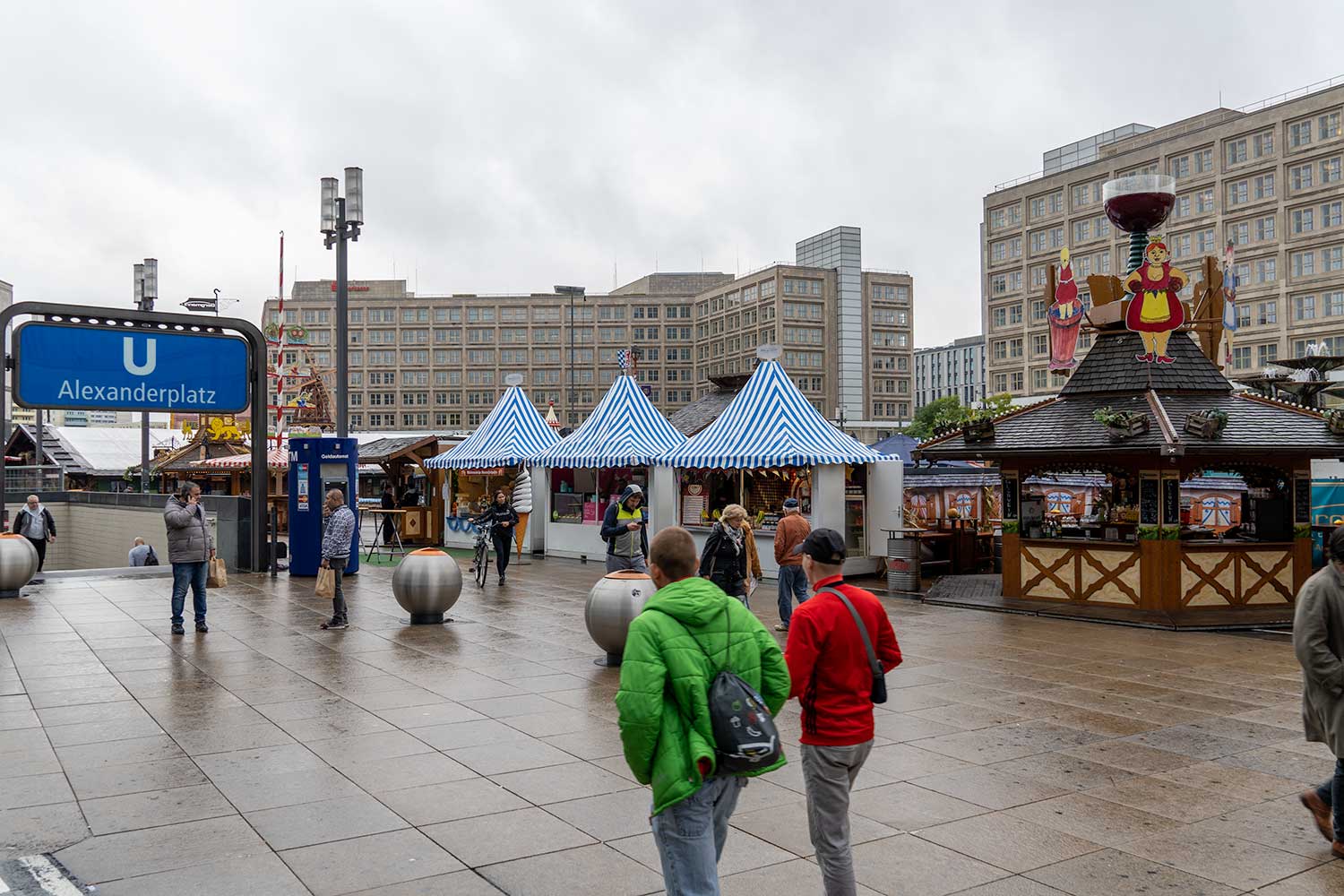 Alexanderplatz: Alexanderplatz—a massive public square and transporation hub—is one of the central points of interest in Berlin. As a major commercial area and one of the most visited parts of Berlin, it connects to a major train station that bears the same name.
Alexanderplatz: Alexanderplatz—a massive public square and transporation hub—is one of the central points of interest in Berlin. As a major commercial area and one of the most visited parts of Berlin, it connects to a major train station that bears the same name.
Alexanderplatz is also one of the most festive parts of Berlin during Oktoberfest. Normally, there are many boutique shops and delicious food stands in this square.
Cost: Free to visit. Recommended Duration of Visit: 1 – 3 hours.
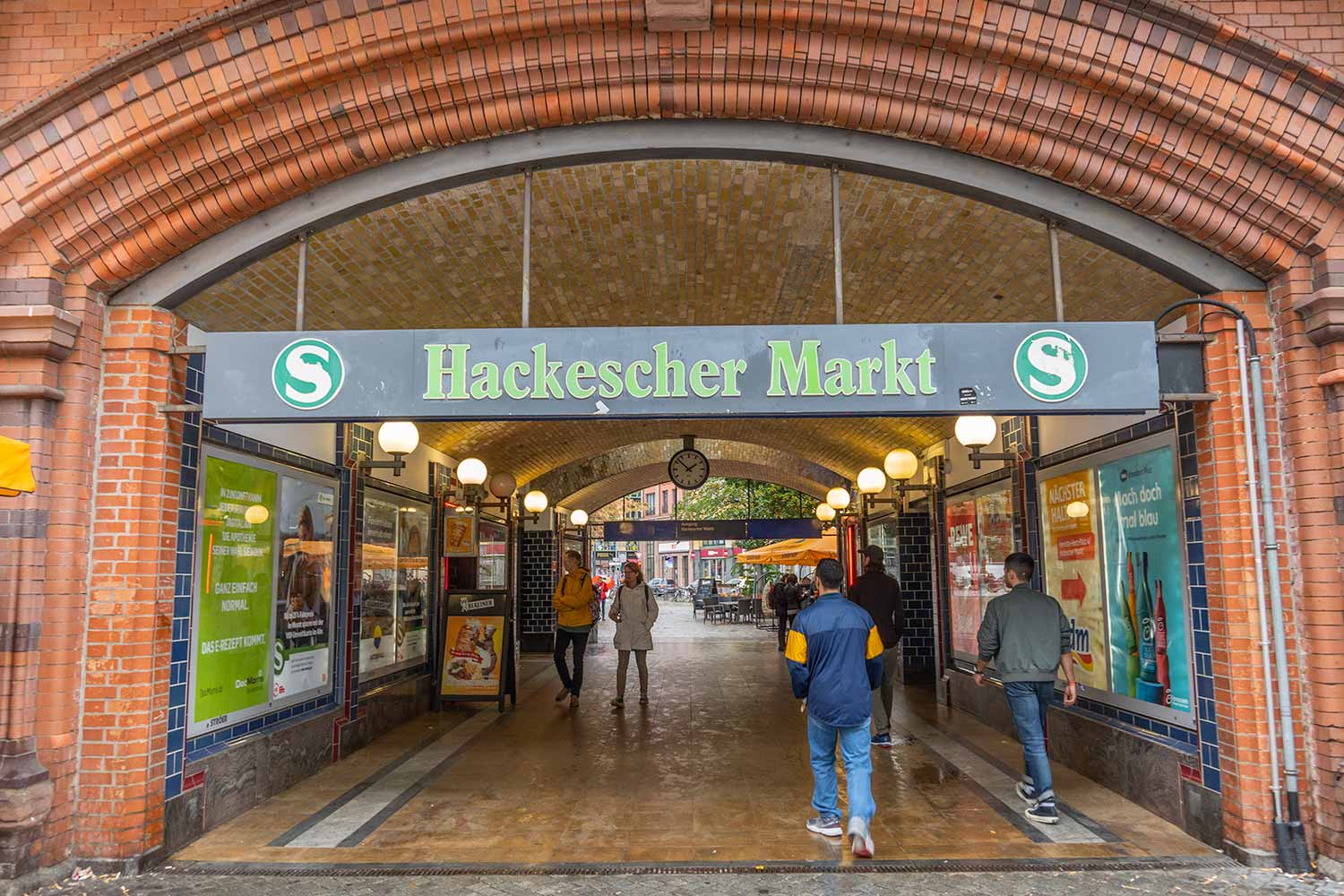 Hackescher Market: Hackescher Market is a very friendly and inviting neighborhood—one with an eclectic selection of bars, courtyards, distinct buildings, graffiti art, shops, cafes, and restaurants. It is a focal point for general festivities and nightlife.
Hackescher Market: Hackescher Market is a very friendly and inviting neighborhood—one with an eclectic selection of bars, courtyards, distinct buildings, graffiti art, shops, cafes, and restaurants. It is a focal point for general festivities and nightlife.
Cost: Free to visit. Recommended Duration of Visit: 1 – 2 hours.
| Alexanderplatz is an excellent starting point to an itinerary. As a major train station, it can take you in most directions. |
| The Anne Frank Zentrum is a very short walk away from the center of Hackescher Market. |
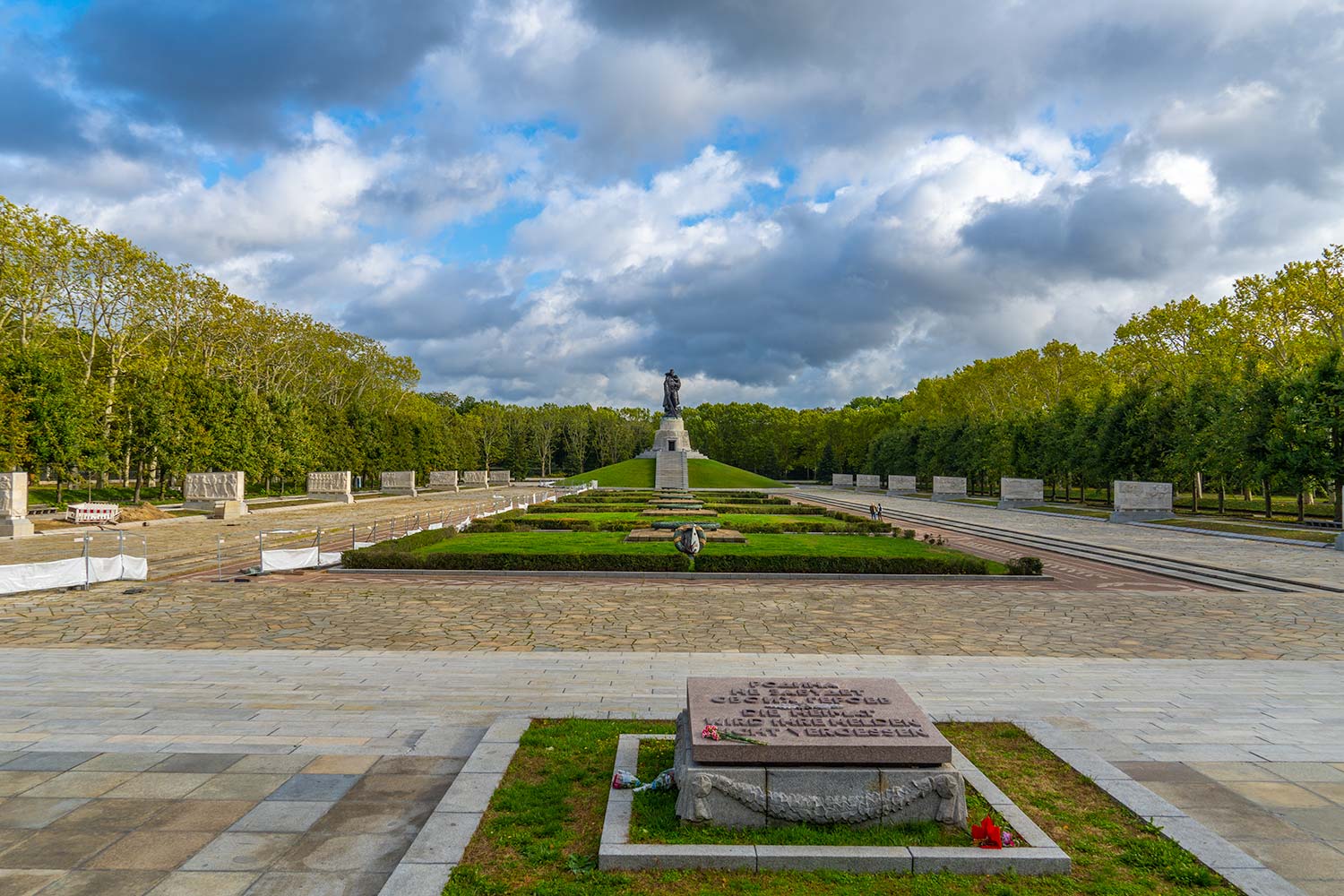 Soviet War Memorial Treptow: The Soviet War Memorial Treptow, located in Treptower Park, commemorates 7000 of the 70000 soldiers who fell in the Battle of Berlin. In fact, the 7000 soldiers are buried at Treptower Park.
Soviet War Memorial Treptow: The Soviet War Memorial Treptow, located in Treptower Park, commemorates 7000 of the 70000 soldiers who fell in the Battle of Berlin. In fact, the 7000 soldiers are buried at Treptower Park.
The memorial is intended to convey an enduring message about victory and the price of freedom. The entire area is vast and beautiful, complete with massive statues, towering structures, and splendid scenery.
Cost: Free to visit. Recommended Duration of Visit: 2 – 3 hours (to explore Treptower Park as well).
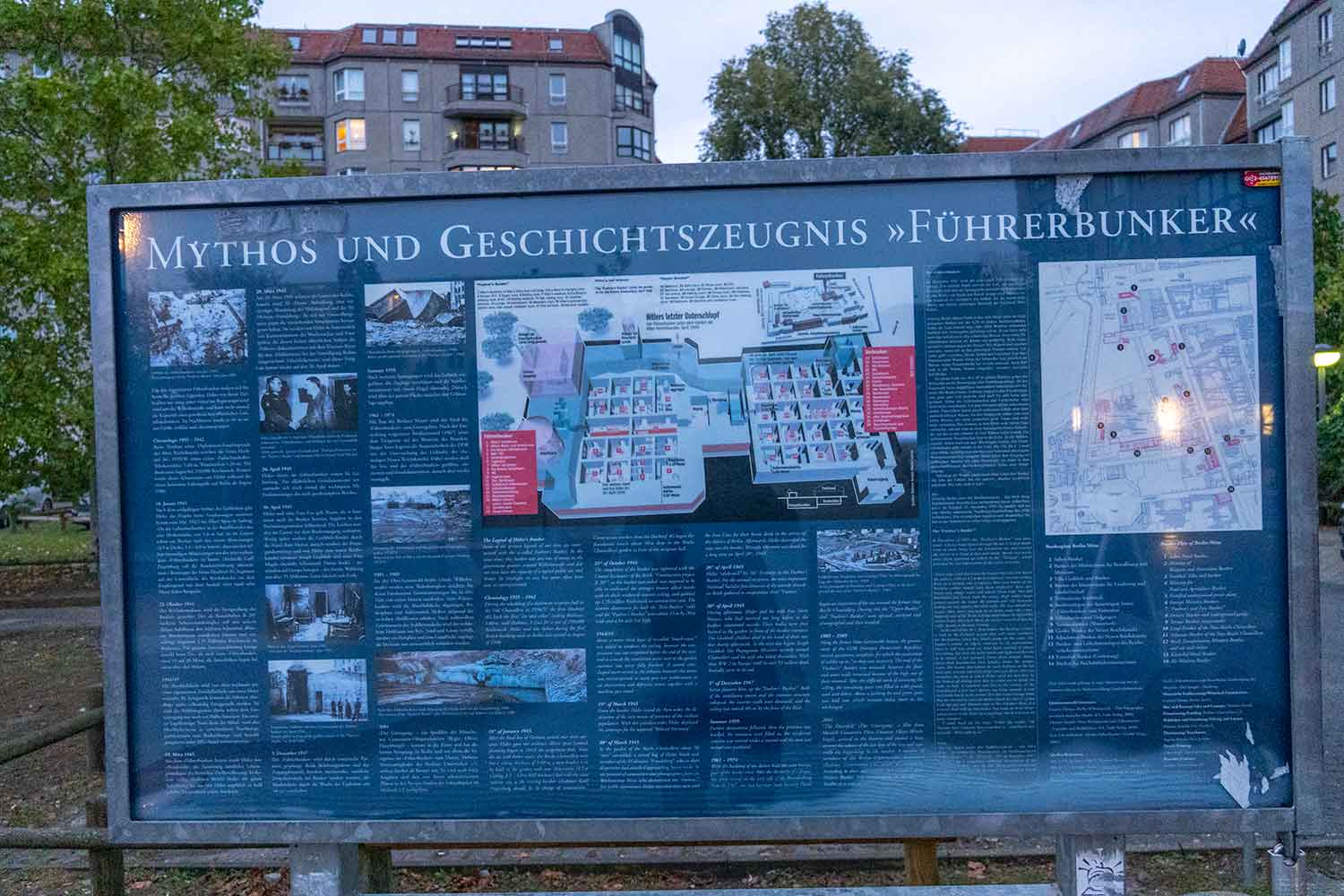 Führerbuker (Hitler’s Bunker): Hitler’s Bunker is one of the great legends in Berlin. Hitler supposedly took up residence in this air raid bunker, making it one of the central points of the Nazi regime. Nothing remains of the bunker after its destruction. Nowadays, it’s just an unexciting parking lot.
Führerbuker (Hitler’s Bunker): Hitler’s Bunker is one of the great legends in Berlin. Hitler supposedly took up residence in this air raid bunker, making it one of the central points of the Nazi regime. Nothing remains of the bunker after its destruction. Nowadays, it’s just an unexciting parking lot.
Cost: Free to Visit. Recommended Duration of Visit: 10 – 15 minutes.
| Treptower Park is one of the furthest attractions from central Berlin, but it is also one of the most peaceful and scenic ones, right alongside the Spree river. You can also rent boats (near Zenner restaurant) for a leisurely cruise. |
| There is just an information board with some history nearby. Seriously though, I don’t recommend visiting unless you have something else planned in the area. The history is cool and all, but there’s really nothing here. |
Attractions are paired up based on similarity and/or proximity. If you wish to visit multiple museums on Museum Island, then I highly recommend the Museum Pass. The main Berlin website allows you to purchase tickets for most attractions.
 Pergamonmuseum (Pergamon Museum): The Pergamon Museum, located on Museum Island, is a UNESCO World Heritage site and one of Germany’s most visited museums.
Pergamonmuseum (Pergamon Museum): The Pergamon Museum, located on Museum Island, is a UNESCO World Heritage site and one of Germany’s most visited museums.
The Pergamon’s main exhibits are its monumental reconstructions such as the Ishtar Gate of Babylon, the Pergamon Altar (from the ancient Greek city of Pergamon), the Market Gate of Miletus, and Mesopotamia, among others. These reconstructions are several stories high and occasionally span the length of an entire room.
There are three main subdivisions: The Antiquity Collection, the Middle East collection, and the Islamic Art collection. The massive reconstructions provide a truly immersive experience—showing visitors what it would be like walking through the past.
Cost: You can find more information and buy tickets on the official Pergamon Museum website. You can also buy tickets in person and select special packaged deals. Recommended Duration of Visit: 2 – 4 hours.
| Unless you are fluent in German, grab a free audio box for translations, because many descriptions are only in German. Backpacks are not allowed, so you will have to check them in. |
 Alte Nationalgalerie (Old National Gallery): The Old National Gallery, located on Museum Island and connected to the Pergamon Museum, is a UNESCO World Heritage Site and a “sanctuary for art and science.” It features Neoclassical, Romantic, and Modernist artwork, among others.
Alte Nationalgalerie (Old National Gallery): The Old National Gallery, located on Museum Island and connected to the Pergamon Museum, is a UNESCO World Heritage Site and a “sanctuary for art and science.” It features Neoclassical, Romantic, and Modernist artwork, among others.
Cost: You can find more information and buy tickets on the official Old National Gallery website. Recommended Duration of Visit: 1 – 2 hours.
| There are kiosks located nearby (outside and inside this museum). These kiosks offer the Museum Pass that gives you access to multiple museums on Museum Island. |
 Brandenburg Gate: Brandenburg Gate was built under the orders of Frederick William II as an entry point into Berlin. As one of the best-known landmarks in Germany, it features elegant 18th century neoclassical architecture. At the gate’s summit is Quadriga—a chariot drawn by four horses. Victoria (the goddess of Victory) commands the chariot.
Brandenburg Gate: Brandenburg Gate was built under the orders of Frederick William II as an entry point into Berlin. As one of the best-known landmarks in Germany, it features elegant 18th century neoclassical architecture. At the gate’s summit is Quadriga—a chariot drawn by four horses. Victoria (the goddess of Victory) commands the chariot.
Throughout history, Brandenburg Gate has been a symbol of division, unity, peace, and the turbulent history of Europe and Germany. It is a major historical site (Napoleon even stole the statue of Quadriga once) and a majestic attraction.
Cost: Free to visit. Recommended Duration of Visit: 30 – 60 minutes.
| Brandenburg Gate is in a very festive and fun area, so you can be here for hours. In my opinion, Brandenburg Gate looks best at night (due to the incredible lighting). If you ask nicely, some people might move aside so you can take your photo. |
 Reichstag Building: This building is the meeting place of the Bundestag—the German federal parliament. The iconic dome was designed to let in copious amounts of sunlight. And even though the dome also has a 360-degree view of Berlin, visitors can simply enjoy a nice view on the roof (outside of the dome). The interior features exhibitions and some history.
Reichstag Building: This building is the meeting place of the Bundestag—the German federal parliament. The iconic dome was designed to let in copious amounts of sunlight. And even though the dome also has a 360-degree view of Berlin, visitors can simply enjoy a nice view on the roof (outside of the dome). The interior features exhibitions and some history.
Cost: Free to visit, but a reservation is necessary. You also need to bring an identity document. You can find more information and buy tickets on the official Reichstag Building website. Recommended Duration of Visit: 1 – 2 hours.
| Reservations should me made at least one day (and preferably two) days in advance. You can also make reservations in person at the booking office. As you face the building, the reservation area is to the right side (in a small building). |
 Siegessäule (Victory Column): The Victory Column, located in the district of Tiergarten, commemorates the Prussian victory in the Danish-Prussian War. The statue of Victoria (the goddess of victory) was added after victories in the Austro-Prussian War and the Franco-Prussian War. The column (including the statue) is 219 feet (67 meters) tall. Some Berliners refer to the statue as Goldelse (Golden Lizzie).
Siegessäule (Victory Column): The Victory Column, located in the district of Tiergarten, commemorates the Prussian victory in the Danish-Prussian War. The statue of Victoria (the goddess of victory) was added after victories in the Austro-Prussian War and the Franco-Prussian War. The column (including the statue) is 219 feet (67 meters) tall. Some Berliners refer to the statue as Goldelse (Golden Lizzie).
Tiergarten is the name of the district and the huge park it contains. This park is worth visiting and contains some very notable attractions such as the Berlin Zoo and the Soviet War Memorial.
Cost: Free to visit, but the entry to the observation deck costs 3 euros (2.5 euros for students). Recommended Duration of Visit: 30 – 60 minutes.
| You can pay to access the Victory Column’s observation deck. Do note that the column is at the center of a giant roundabout. |
 Soviet War Memorial Tiergarten: This memorial, located in Tiergarten Park, was erected by the Soviet Union to commemorate the fallen soldiers in the Battle of Berlin. It was erected in 1945, within a few months of capturing Berlin.
Soviet War Memorial Tiergarten: This memorial, located in Tiergarten Park, was erected by the Soviet Union to commemorate the fallen soldiers in the Battle of Berlin. It was erected in 1945, within a few months of capturing Berlin.
The memorial is surrounded by artillery and tanks. The inscription translates as, “Eternal glory to heroes who fell in battle with the German fascist invaders for the freedom and independence of the Soviet Union.” It is also the burial site of about 2,000 Soviet soldiers.
Cost: Free to visit. Recommended Duration of Visit: 15 – 30 minutes.
| There is a small outdoor museum behind the memorial that provides some history. |
 Berlin Wall: From 1961 to 1989, this concrete wall represented the physical and ideological division in Berlin. At the end of World War 2, Berlin was divided into four zones. The eastern half was the Soviet zone. The western half was divided into American, British, and French zones.
Berlin Wall: From 1961 to 1989, this concrete wall represented the physical and ideological division in Berlin. At the end of World War 2, Berlin was divided into four zones. The eastern half was the Soviet zone. The western half was divided into American, British, and French zones.
The wall was built to prevent the mass exodus of people from the East (because the West was more prosperous). As a major historic landmark, the wall’s construction symbolized division, and its destruction symbolized unity.
This section of the wall is near the Topography of Terror—a center documenting Nazi atrocities. This location also provides a detailed history of World War 2. Most notably, the information boards showcase the bravery and sacrifice of Poland.
Cost: Free to visit. Recommended Duration of Visit: 1 – 2 hours.
| This section of the Berlin Wall, located at Niederkirchnerstraße 1, 10117 Berlin, is west of Checkpoint Charlie—a historical crossing point between East and West Berlin during the Cold War. |
 East Side Gallery: This open-air gallery—featuring murals painted directly on a section of the Berlin Wall—is one of the largest open-air galleries in the world. At 4318 feet (1316 meters) long, the East Side Gallery offers a lovely walk along the river, mesmerizing street art that encompasses the history and culture of Berlin, a rich history, and a festive atmosphere. This memorial to the fall of the Berlin Wall consists of over 100 artworks.
East Side Gallery: This open-air gallery—featuring murals painted directly on a section of the Berlin Wall—is one of the largest open-air galleries in the world. At 4318 feet (1316 meters) long, the East Side Gallery offers a lovely walk along the river, mesmerizing street art that encompasses the history and culture of Berlin, a rich history, and a festive atmosphere. This memorial to the fall of the Berlin Wall consists of over 100 artworks.
The world-renowned masterpiece (the one with the two men kissing), created by Russian painter Dmitri Vrubel, depicts the Soviet leader Leonid Brezhnev and the East Germany President Erich Honecker passionately kissing.
Yes, the two men indeed kissed (and they were REALLY into it). “The Kiss” was a special form of greeting to demonstrate a special connection between socialist countries. The text translates to: “My God, help me to survive this deadly love.”
Cost: Free to visit. Recommended Duration of Visit: 1 – 2 hours.
| Since the East Side Gallery is a very long section of the Berlin Wall, you might have to walk a while before you start seeing reconizable art (like the one shown above). |
 Berlin Cathedral: The Berlin Cathedral, located on Museum Island, is one of the most recognizable sites in Berlin. The interior of this massive Evangelical cathedral is striking, leaving one in awe of its unique architectural design and sheer vastness.
Berlin Cathedral: The Berlin Cathedral, located on Museum Island, is one of the most recognizable sites in Berlin. The interior of this massive Evangelical cathedral is striking, leaving one in awe of its unique architectural design and sheer vastness.
The cathedral also features a rich history, numerous elaborate exhibits, ornate displays, and a crypt, among others. As a bonus, there is an observation deck that offers a breathtaking panoramic view of Berlin’s skyline. There is also a cafe (toward the exit). If you refer to my Berlin Cathedral Guide, then you will see how truly amazing this place is.
Cost: You can find more information and buy tickets on the official Berlin Cathedral website. Recommended Duration of Visit: 1 – 2 hours.
| It takes about 257 steps to reach the observation deck. For the best view, try to visit around noon or sunset. |
| St. Mary’s Church is in a centralized location, giving you maximum flexibility to head in any direction as you plan your itinerary. |
 Holocaust Memorial (Memorial to the Murdered Jews of Europe): This memorial, dedicated to the Jewish victims of the Holocaust, consists of 2711 gray concrete stelae (slabs) arranged on a sloping field that spans 200,000 square feet (18,600 square meters).
Holocaust Memorial (Memorial to the Murdered Jews of Europe): This memorial, dedicated to the Jewish victims of the Holocaust, consists of 2711 gray concrete stelae (slabs) arranged on a sloping field that spans 200,000 square feet (18,600 square meters).
The Place of Information (underground exhibit) holds the names of approximately 3 million Jewish Holocaust victims. In the underground exhibit, there is a timeline of events alongside displays of heartbreaking letters of victims. One of the memorial’s most profound messages is: “It happened, therefore it can happen again: this is the core of what we have to say.”
Cost: The memorial is free to visit, but the underground exhibit costs a small fee (3 euros when I went). Recommended Duration of Visit: 1 – 2 hours.
| The exhibit entrance is near the outer edge. The exhibit is closed on Mondays. Photography of the entrance is prohibited. The Jewish Memorial is north of the Berlin Wall (the one near the Topography of Terror), but visiting both in the same day can be saddening because they cover some horrific events. I recommend separating these attractions into two separate dates if possible. |
 Anne Frank Zetrium (Anne Frank Center): Anne Frank’s diary (i.e. The Diary of a Young Girl) is world-renowned and widely-praised for its literary merits, moving story, and profound wisdom. As a symbol of the Holocaust, she was one voice that spoke for the 6 million victims.
Anne Frank Zetrium (Anne Frank Center): Anne Frank’s diary (i.e. The Diary of a Young Girl) is world-renowned and widely-praised for its literary merits, moving story, and profound wisdom. As a symbol of the Holocaust, she was one voice that spoke for the 6 million victims.
This wonderful museum contains very detailed accounts of Anne Frank’s life and the world she lived in—complete with descriptions, interviews, letters, and photographs. The Zentrum’s goal is to work against any kind of discrimination against people.
Cost: You can find more information and buy tickets on the official Anne Frank Zetrium website. Recommended Duration of Visit: 1 – 2 hours.
| The audio guides are integral to a complete experience. The Museum caters to the deaf and blind as well. This museum contains an abundant amount of text, videos, and photographs, so it should not be rushed. The entrance is slightly tricky to find, so make sure to look for the stairways next to the artwork of Anne Frank (shown in the photo). |
 Fernsehturm (Television Tower): As one of the most recognized landmarks in Berlin, the Fernsehturm stands at 1207 feet (368 meters), making it is easily one of the tallest freestanding structures in Europe.
Fernsehturm (Television Tower): As one of the most recognized landmarks in Berlin, the Fernsehturm stands at 1207 feet (368 meters), making it is easily one of the tallest freestanding structures in Europe.
The observation deck (the sphere-looking thing) is at 666 feet ( 203 meters), providing a panoramic view of the city. The lift takes approximately 40 seconds to reach the observation deck. There is a cool bar (Bar 203) on the observation deck floor.
Cost: You can find more information and buy tickets on the official Fernsehturm website. Recommended Duration of Visit: 1 – 2 hours.
| Note that protective glass surrounds the observation deck, so taking photos is slightly trickier. |
 Neptunbrunnen (Neptune Fountain): The Neptune Fountain, based on the Roman god Neptune, was built in 1891. Four women surround Neptune—each of them representing one of the 4 main rivers in Prussia (Elbe, Rhine, Vistula, and Oder).
Neptunbrunnen (Neptune Fountain): The Neptune Fountain, based on the Roman god Neptune, was built in 1891. Four women surround Neptune—each of them representing one of the 4 main rivers in Prussia (Elbe, Rhine, Vistula, and Oder).
The fountain’s diameter is 59 feet (18 meters) and its height is 33 feet (10 meters).
Cost: Free to visit. Recommended Duration of Visit: 10 – 15 minutes.
| The fountain is in a centralized location (near St. Mary’s Church), making it a flexible location for itinerary planning. |
 Alexanderplatz: Alexanderplatz—a massive public square and transporation hub—is one of the central points of interest in Berlin. As a major commercial area and one of the most visited parts of Berlin, it connects to a major train station that bears the same name.
Alexanderplatz: Alexanderplatz—a massive public square and transporation hub—is one of the central points of interest in Berlin. As a major commercial area and one of the most visited parts of Berlin, it connects to a major train station that bears the same name.
Alexanderplatz is also one of the most festive parts of Berlin during Oktoberfest. Normally, there are many boutique shops and delicious food stands in this square.
Cost: Free to visit. Recommended Duration of Visit: 1 – 3 hours.
| Alexanderplatz is an excellent starting point to an itinerary. As a major train station, it can take you in most directions. |
 Hackescher Market: Hackescher Market is a very friendly and inviting neighborhood—one with an eclectic selection of bars, courtyards, distinct buildings, graffiti art, shops, cafes, and restaurants. It is a focal point for general festivities and nightlife.
Hackescher Market: Hackescher Market is a very friendly and inviting neighborhood—one with an eclectic selection of bars, courtyards, distinct buildings, graffiti art, shops, cafes, and restaurants. It is a focal point for general festivities and nightlife.
Cost: Free to visit. Recommended Duration of Visit: 1 – 2 hours.
| The Anne Frank Zentrum is a very short walk away from the center of Hackescher Market. |
 Soviet War Memorial Treptow: The Soviet War Memorial Treptow, located in Treptower Park, commemorates 7000 of the 70000 soldiers who fell in the Battle of Berlin. In fact, the 7000 soldiers are buried at Treptower Park.
Soviet War Memorial Treptow: The Soviet War Memorial Treptow, located in Treptower Park, commemorates 7000 of the 70000 soldiers who fell in the Battle of Berlin. In fact, the 7000 soldiers are buried at Treptower Park.
The memorial is intended to convey an enduring message about victory and the price of freedom. The entire area is vast and beautiful, complete with massive statues, towering structures, and splendid scenery.
Cost: Free to visit. Recommended Duration of Visit: 2 – 3 hours (to explore Treptower Park as well).
| Treptower Park is one of the furthest attractions from central Berlin, but it is also one of the most peaceful and scenic ones, right alongside the Spree river. You can also rent boats (near Zenner restaurant) for a leisurely cruise. |
 Führerbuker (Hitler’s Bunker): Hitler’s Bunker is one of the great legends in Berlin. Hitler supposedly took up residence in this air raid bunker, making it one of the central points of the Nazi regime. Nothing remains of the bunker after its destruction. Nowadays, it’s just an unexciting parking lot.
Führerbuker (Hitler’s Bunker): Hitler’s Bunker is one of the great legends in Berlin. Hitler supposedly took up residence in this air raid bunker, making it one of the central points of the Nazi regime. Nothing remains of the bunker after its destruction. Nowadays, it’s just an unexciting parking lot.
Cost: Free to Visit. Recommended Duration of Visit: 10 – 15 minutes.
| There is just an information board with some history nearby. Seriously though, I don’t recommend visiting unless you have something else planned in the area. The history is cool and all, but there’s really nothing here. |
Oktoberfest
Oktoberfest—the largest beer festival in the world—originated in Munich in 1810. Although Munich receives more attention and draws a larger tourist crowd in general, Berlin is still incredibly fun and festive. In fact, Berlin is almost thrice the size of Munich and has more than twice the population. In terms of festivals, Oktoberfest is one of the most famous in the world, and any adventurous spirit should attend.
It is very important to know the time range of Oktoberfest. It usually begins the third weekend of September through the first weekend of October and lasts a little over 2 weeks. In other words, most of Oktoberfest isn’t even in October.
Rentable Scooters
Rentable scooters are amazing. This method of transportation was previously unavailable until technology advanced sufficiently. While railways are cheaper, scooters are far more efficient and fun when navigating Berlin. With all the dedicated lanes for bikes and scooters, the city is practically built for it.
Once you become familiar with them, riding scooters throughout Berlin is exhilarating and safe (as long as you don’t do something stupid). Trust me when I say that these scooters will greatly enhance your Berlin experience. They are still much cheaper than taxis, so you can still try and see if they’re to your liking.
Several companies offer rentable scooters throughout Berlin (i.e. Uber and Lime).
Teufelsberg Adventure
Teufelsberg—a man-made hill at the center of a forest—was a secretive listening station during the Cold War. It is most notable for its four massive radomes—a weatherproof structure that protects radio antenna. Interestingly, Teufelsberg is entirely fenced off—like a prison.
The best way to travel to Teufelsberg is via rentable scooters scattered throughout the city. This method of transportation greatly enhances the experience in Berlin because the city is perfectly built for it. Scooters are much cheaper and more fun than taxis.
You will travel through much of Berlin as you soak in the atmosphere, culture, and way of life. Naturally, this immersive experience will greatly enhance your Berlin experience. Despite traveling in mostly a straight line, you will pass through major attractions such as the Berlin Cathedral, Brandenburg Gate, and Tiergarten. Only toward the end will you follow some turns leading up to Teufelsberg.
The journey to Teufelsberg (on a scooter) was one of the most liberating, exhilarating, and thoroughly entertaining experiences of my life. Due to a series of bad luck, my time in Berlin was mediocre at best. The Teufelsberg adventure easily and thoroughly convinced me that Berlin was actually one of my favorite cities.
More information on Spreegold Store Ros 02
What to order: I recommend the Sunshine Coconut Yogurt. It consists of strawbery, raspberry, yogurt, coconut, and mango. The Acai Yogurt is a solid option as well.
More information on Monsieur Vuong
What to order: I recommend ordering the basic Pho. No need to get fancy.
More information on Pergamon Döner
What to order: I recommend the Donerteller. It is a classic, sizable, and delicious meal at a great price. In general, you can’t go wrong if you get the kebab. The Falafel is a great vegetarian option, too. The Baklava is a great dessert option as well.
More information on Gumus Bistro
What to order: Once again, the Donerteller is a great meal at a great price. This location serves more vegetables.
More information on Curry 61
What to order: Naturally, I recommend the Traditional Currywurst.
More information on Hofbräu Wirtshaus Berlin
What to order: I honestly just went here for drinks, but I hear the German food is decent 😂.
More information on Amorino Eisboutique
What to order: The Classic Cone gets you 5 flavors molded into the shape of a flower. In my opinion, the mango and strawbery flavors are the best.
More information on Spreegold Store Ros 02
What to order: I recommend the Sunshine Coconut Yogurt. It consists of strawbery, raspberry, yogurt, coconut, and mango. The Acai Yogurt is a solid option as well.
More information on Monsieur Vuong
What to order: I recommend ordering the basic Pho. No need to get fancy.
More information on Pergamon Döner
What to order: I recommend the Donerteller. It is a classic, sizable, and delicious meal at a great price. In general, you can’t go wrong if you get the kebab. The Falafel is a great vegetarian option, too. The Baklava is a great dessert option as well.
More information on Gumus Bistro
What to order: Once again, the Donerteller is a great meal at a great price. This location serves more vegetables.
More information on Curry 61
What to order: Naturally, I recommend the Traditional Currywurst.
More information on Hofbräu Wirtshaus Berlin
What to order: I honestly just went here for drinks, but I hear the German food is decent 😂.
More information on Amorino Eisboutique
What to order: The Classic Cone gets you 5 flavors molded into the shape of a flower. In my opinion, the mango and strawbery flavors are the best.
As one of the largest cities in Europe (and the largest city in the European Union), Berlin’s nightlife is pretty wild. Tresor Berlin, Berghain, and Watergate are some of the most popular nightclubs in Berlin. Do note that these clubs are relatively far from the city center. Tresor is the least far and Watergate is the farthest.
Matrix Club Berlin is a pretty fun Disco club. Hafenbar Berlin and Knutschfleck Berlin are some very nice bars in central Berlin. As previously mentioned in the Food section, Hofbräu Wirtshaus Berlin is a mix between a bar and a restaurant.
Berlin is safe, clean, easy to navigate, and beautiful. Although it did not initially strike me as an interesting destination, it has certainly changed my mind. The city is vibrant, the history is incredible, and some of my fondest memories are from here (especially the Teufelsberg Adventure).
On a final note, make sure to share this page so others will know more about Berlin!

 © Copyright - Ace AdventurerA Guide to the Berlin Cathedral: Things to See and Do
© Copyright - Ace AdventurerA Guide to the Berlin Cathedral: Things to See and Do